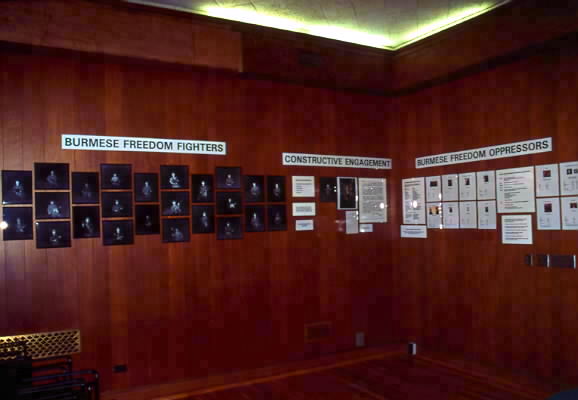
CONSTRUCTIVE ENGAGEMENT
In 1996, I was given access to a series of photos of rebel soldiers from the
Karen National Liberation Army. I had visited Burma in 1994 (see the photo show
in the world travel section of the website), and had even planned on making
a documentary film in the country in 1995, for which I was told I would receive
official permission. I assembled a film crew in Bangkok, and prepared for the
project, but then backed out when it became apparent that the dictatorship,
appearances at the time notwithstanding, had no plans to open up to democracy.
Instead, the generals were merely seeking to create some favorable press. (It
was following this experience that I became a committed democracy activist.)
On seeing the photos, I realized they had to be published, and I conceived of
the Constructive Engagement show, as a means to debunk the policy with this
name (which states that doing business with - “constructively engaging”
- repressive regimes will inevitably lead them, some day, or some century,
to accomplish a transition to democracy), and also to call on the U.S. government
to enact sanctions against the dictatorship. I went to the United States, and
had the good fortune to arrive just before the first national convention of
the Free Burma Coalition. Through an activist connection I contacted FBC, and
although I was an unknown to them and they were very pressed for time, they
agreed to give me wall space at the conference.
The show contrasts the conditions of the rebels with those of the well-paid
Chief Executive Officers of the companies which do business with, and thereby
fund, the dictatorship. Its focal point is a photo of a child soldier (the same
photo as in our banner - of Donnie), and a letter he wrote which describes his
life. The images below document two of the show’s eight incarnations, which
number would have been higher had economic sanctions not been signed into law
by President Clinton while we were on tour. (This was an exhilarating moment
for me, when I found out that - contrary to normal activist experience - the
U.S. government had done what we wanted.)
Three of the images from the exhibit: if you came this far, please look at these.
The associated article
and text boards for the exhibit:
- Constructive Engagement
- Selected text boards
In a conference room at the University of North Carolina.
At an all
day activist fair and concert next to the University of Oklahoma,
for which display we built three billboards.
© Roland O. Watson 2001-3